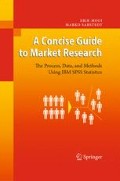Abstract
Grouping similar customers and products is a fundamental marketing activity. It is used, prominently, in market segmentation. As companies cannot connect with all their customers, they have to divide markets into groups of consumers, customers, or clients (called segments) with similar needs and wants. Firms can then target each of these segments by positioning themselves in a unique segment (such as Ferrari in the high-end sports car market). While market researchers often form market segments based on practical grounds, industry practice and wisdom, cluster analysis allows segments to be formed that are based on data that are less dependent on subjectivity.
Learning Objectives
After reading this chapter you should understand:
– The basic concepts of cluster analysis.
– How basic cluster algorithms work.
– How to compute simple clustering results manually.
– The different types of clustering procedures.
– The SPSS clustering outputs.
Access this chapter
Tax calculation will be finalised at checkout
Purchases are for personal use only
Notes
- 1.
See Wedel and Kamakura (2000).
- 2.
Tonks (2009) provides a discussion of segment design and the choice of clustering variables in consumer markets.
- 3.
- 4.
- 5.
Note that researchers also often use the squared Euclidean distance.
- 6.
See Milligan and Cooper (1988).
- 7.
See Wedel and Kamakura (2000) for more information on alternative matching coefficients.
- 8.
Milligan and Cooper (1985) compare various criteria.
- 9.
Note that the k-means algorithm is one of the simplest non-hierarchical clustering methods. Several extensions, such as k-medoids (Kaufman and Rousseeuw 2005) have been proposed to handle problematic aspects of the procedure. More advanced methods include finite mixture models (McLachlan and Peel 2000), neural networks (Bishop 2006), and self-organizing maps (Kohonen 1982). Andrews and Currim (2003) discuss the validity of some of these approaches.
- 10.
Note this holds for the algorithms original design. SPSS does not choose centers randomly.
- 11.
Conversely, SPSS always sets one observation as the cluster center instead of picking some random point in the dataset.
- 12.
See Punji and Stewart (1983) for additional information on this sequential approach.
- 13.
For further information, see Palmieri JE (2008). “Saks Adds Men’s Accessories Shops,” Women’s Wear Daily, 196 (128), 14.
- 14.
Note that the data are artificial.
References
Andrews RL, Currim IS (2003) Recovering and profiling the true segmentation structure in markets: an empirical investigation. Int J Res Mark 20(2):177–192
Arabie P, Hubert L (1994) Cluster analysis in marketing research. In: Bagozzi RP (ed) Advanced methods in marketing research. Blackwell, Cambridge, pp 160–189
Bishop CM (2006) Pattern recognition and machine learning. Springer, Berlin
Calinski, T, Harabasz J (1974) A dendrite method for cluster analysis. Commun Stat Theory Methods 3(1):1–27
Chiu T, Fang D, Chen J, Wang Y, Jeris C (2001) A robust and scalable clustering algorithm for mixed type attributes in large database environment. In: Proceedings of the 7th ACM SIGKDD international conference in knowledge discovery and data mining, Association for Computing Machinery, San Francisco, CA, pp 263–268
Dibb S (1999) Criteria guiding segmentation implementation: reviewing the evidence. J Strateg Mark 7(2):107–129
Dolnicar S (2003) Using cluster analysis for market segmentation – typical misconceptions, established methodological weaknesses and some recommendations for improvement. Australas J Mark Res 11(2):5–12
Dolnicar S, Grün B (2009) Challenging “factor-cluster segmentation”. J Travel Res 47(1):63–71
Dolnicar S, Lazarevski K (2009) Methodological reasons for the theory/practice divide in market segmentation. J Mark Manage 25(3–4):357–373
Formann AK (1984) Die Latent-Class-Analyse: Einführung in die Theorie und Anwendung. Beltz, Weinheim
Kaufman L, Rousseeuw PJ (2005) Finding groups in data. An introduction to cluster analysis. Wiley, Hoboken, NY
Kohonen T (1982) Self-organized formation of topologically correct feature maps. Biol Cybern 43(1):59–69
Kotler P, Keller KL (2009) Marketing management, 13th edn. Pearson Prentice Hall, Upper Saddle River, NJ
Larson JS, Bradlow ET, Fader PS (2005) An exploratory look at supermarket shopping paths. Int J Res Mark 22(4):395–414
McLachlan GJ, Peel D (2000) Finite mixture models. Wiley, New York, NY
Milligan GW, Cooper M (1985) An examination of procedures for determining the number of clusters in a data set. Psychometrika 50(2):159–179
Milligan GW, Cooper M (1988) A study of variable standardization. J Classification 5(2):181–204
Moroko L, Uncles MD (2009) Employer branding and market segmentation. J Brand Manage 17(3):181–196
Okazaki S (2006) What do we know about Mobile Internet Adopters? A Cluster Analysis. Inf Manage 43(2):127–141
Punji G Stewart DW (1983) Cluster analysis in marketing research: review and suggestions for application. J Mark Res 20(2):134–148
Sheppard A (1996) The sequence of factor analysis and cluster analysis: differences in segmentation and dimensionality through the use of raw and factor scores,” tourism analysis. Tourism Anal 1(Inaugural Volume):49–57
Tonks DG (2009) Validity and the design of market segments. J Mark Manage 25(3–4):341–356
Wedel M, Kamakura WA (2000) Market segmentation: conceptual and methodological foundations, 2nd edn. Kluwer, Boston, NE
Author information
Authors and Affiliations
Rights and permissions
Copyright information
© 2010 Springer Berlin Heidelberg
About this chapter
Cite this chapter
Mooi, E., Sarstedt, M. (2010). Cluster Analysis. In: A Concise Guide to Market Research. Springer, Berlin, Heidelberg. https://doi.org/10.1007/978-3-642-12541-6_9
Download citation
DOI: https://doi.org/10.1007/978-3-642-12541-6_9
Published:
Publisher Name: Springer, Berlin, Heidelberg
Print ISBN: 978-3-642-12540-9
Online ISBN: 978-3-642-12541-6
eBook Packages: Business and EconomicsBusiness and Management (R0)

